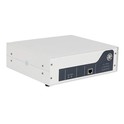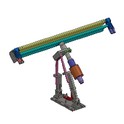Hey there, power plant folks! I'm a supplier of ultrasonic rings, and I'm stoked to share with you how these nifty devices can be a game - changer in your power plants.
What are Ultrasonic Rings?
First off, let's get on the same page about what ultrasonic rings are. Ultrasonic rings are basically devices that generate ultrasonic waves. These waves create a phenomenon called cavitation. In simple terms, tiny bubbles form and collapse rapidly in the liquid around the ring. This process can do some pretty amazing things in a power plant setting.
Benefits of Using Ultrasonic Rings in Power Plants
Cleaning Heat Exchangers
Heat exchangers are a crucial part of power plants. Over time, they can get clogged with all sorts of gunk like scale, rust, and bio - fouling. This buildup reduces the efficiency of the heat exchanger, which means your power plant has to work harder and use more energy.
That's where our ultrasonic rings come in. You can install them around the pipes of the heat exchanger. The ultrasonic waves generated by the ResoRing - 25 Ultrasonic Ring or ResoRing - 30 Ultrasonic Ring will create cavitation in the fluid flowing through the pipes. The collapsing bubbles dislodge the deposits on the inner walls of the pipes, keeping them clean. This not only improves the heat transfer efficiency but also extends the lifespan of the heat exchanger.
Preventing Scale Formation
Scale is a real headache in power plants. It forms when minerals in the water precipitate out and stick to the surfaces of equipment. If left unchecked, scale can cause blockages and reduce the flow of water and steam.
Ultrasonic rings can help prevent scale formation. The ultrasonic waves disrupt the crystallization process of the minerals in the water. Instead of forming large, hard - to - remove scale deposits, the minerals stay in suspension and can be easily flushed out. This means less maintenance and fewer breakdowns due to scale - related issues.
Reducing Bio - Fouling
Bio - fouling occurs when microorganisms like bacteria, algae, and barnacles attach themselves to the surfaces of equipment in contact with water. This can lead to corrosion, reduced flow, and decreased efficiency.
The ultrasonic waves from our rings create an environment that's inhospitable to these microorganisms. The constant agitation and pressure changes caused by cavitation prevent the organisms from attaching to the surfaces. So, you can keep your water - based systems clean and running smoothly.
How to Install Ultrasonic Rings in Power Plants
Step 1: Assessment
Before installing the ultrasonic rings, you need to assess your power plant's specific needs. Figure out which parts of the plant are most affected by scale, fouling, or other issues. This could be the heat exchangers, cooling towers, or water pipes.


Step 2: Selecting the Right Ring
Based on your assessment, choose the appropriate ultrasonic ring. Our ResoRing - 25 Ultrasonic Ring is great for smaller pipes and systems with lower flow rates. If you have larger pipes or higher - volume systems, the ResoRing - 30 Ultrasonic Ring might be a better fit.
Step 3: Installation
Installing the ultrasonic rings is relatively straightforward. First, clean the surface of the pipe where you'll be attaching the ring. Then, wrap the ring around the pipe and secure it in place. Make sure it's tightly fitted so that the ultrasonic waves can be effectively transmitted into the fluid inside the pipe.
Step 4: Connection and Testing
Connect the ultrasonic ring to a power source. Most of our rings come with a simple plug - and - play setup. Once connected, turn on the power and let the ring run for a while. Monitor the system to make sure everything is working properly. You should start to see a reduction in scale and fouling within a few weeks.
Maintenance of Ultrasonic Rings
Maintaining ultrasonic rings is a breeze. All you need to do is check the ring periodically for any signs of damage or wear. Clean the surface of the ring if it gets dirty. The power supply unit should also be inspected to ensure it's functioning correctly.
Since the rings don't have any moving parts, there's not much that can go wrong. But it's always a good idea to have a spare ring on hand in case of an emergency.
Cost - Effectiveness
Using ultrasonic rings in your power plant is a cost - effective solution. While there is an initial investment in purchasing and installing the rings, the long - term savings are significant. You'll save on energy costs because your equipment will be running more efficiently. You'll also save on maintenance costs since you won't have to clean or replace equipment as often due to scale and fouling.
Real - World Success Stories
We've had many power plants that have seen great results after installing our ultrasonic rings. One power plant in the Midwest was struggling with scale buildup in their heat exchangers. After installing our ResoRing - 30 Ultrasonic Ring, they noticed a significant improvement in heat transfer efficiency. They were able to reduce their energy consumption by 15% and cut down on maintenance costs by 20%.
Another power plant on the East Coast was dealing with bio - fouling in their cooling towers. Our ResoRing - 25 Ultrasonic Ring helped them keep the towers clean and reduced the frequency of chemical treatments. This not only saved them money but also made their operations more environmentally friendly.
Conclusion
So, there you have it - how to use ultrasonic rings in power plants. These little devices can make a big difference in the efficiency and reliability of your power plant. Whether it's cleaning heat exchangers, preventing scale formation, or reducing bio - fouling, our ultrasonic rings are up to the task.
If you're interested in learning more about how our ultrasonic rings can benefit your power plant, or if you're ready to make a purchase, don't hesitate to reach out. Let's have a chat and see how we can work together to improve your power plant's performance.
References
- "Ultrasonic Cleaning Technology in Industrial Applications" - A research paper on the use of ultrasonic waves for cleaning in industrial settings.
- "Power Plant Maintenance and Efficiency" - A book that covers various methods to improve the efficiency and reduce maintenance in power plants.






